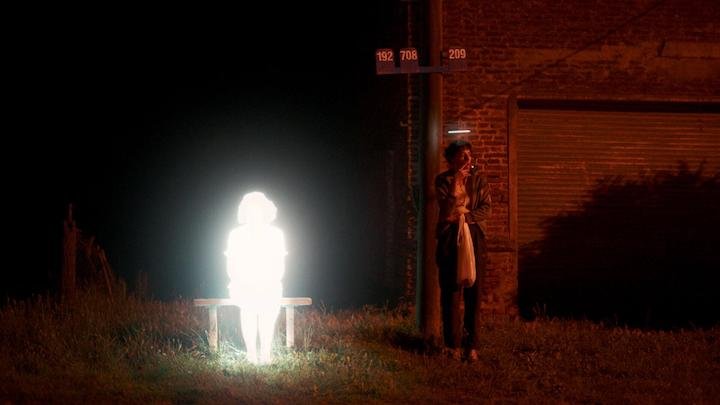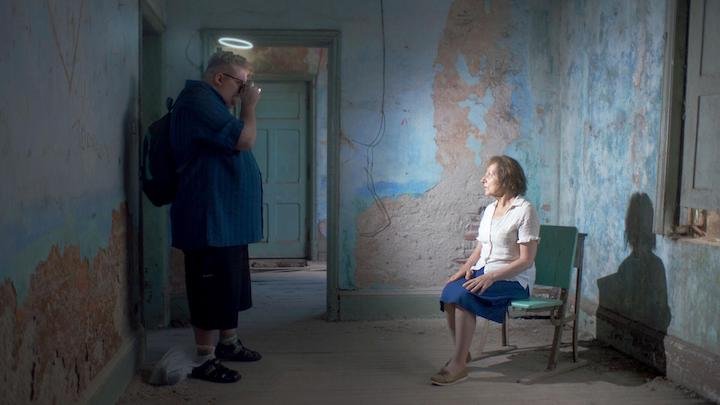Chronicles of a Wandering Saint (Crónicas de una santa errante), the first feature film from filmmaker Tomás Gómez Bustillo, will have two screenings at this year’s SFiFF.
The village of Antonio Carboni (population 296), named after a former landowner, sits on flatlands southwest of Buenos Aires, Argentina, a few hours by car from La Pampa province where bulls still graze on vast grasslands. This village of dirt roads flanked by foxtails comprises a few dozen flat brick buildings and casitas, coconut trees that stick out from behind weeping Tipuana tipu trees and jacarandas, a once elegant train station (no longer in use), and a church famous for the mechanism of its clock that came all the way from Paris after the Great War. In other words, it’s a perfect film set.
Writer-director Tomás Gómez Bustillo knew Antonio Carboni and its residents well, even before he began shooting there for his first feature film, Chronicles of a Wandering Saint (Crónicas de una santa errante) — a surrealistic comedy competing at the Santa Fe International Film Festival. The film tells the story of Rita (played by Mónica Villa), a middle-aged and rather shy village woman who dreams of glory and adoration. With the help of her long-suffering and loving husband, Norberto (Horacio Marassi), she stages her own religious miracle. And, like Icarus, she comes too close to the sun.
The director, who grew up across Argentina, El Salvador, Costa Rica, and the U.S. and who currently lives in Los Angeles, had traveled to Carboni on numerous occasions between the ages of 17 and 21 as a Catholic missionary. I ask the now-agnostic 33-year-old Latino filmmaker what he means by “Catholic missionary.” Surely, Argentina is majority Catholic, and the residents of Carboni, called carbonenses, with their famous parish of the Sagrada Familia and that famous clock atop its tower, did not need converting to their own religion.
Gómez Bustillo laughs. “It’s a very common thing [in Argentina] in middle class and upper middle class,” he says. “Especially in your last years of high school and early years of college, you kind of join a missionary group. And you’re young, and it’s fun, and you take guitars with you, and it just feels almost like a traveling band.”
Despite any fun he may have had as a missionary, Gómez Bustillo says, “It was a strange experience for me. I was a silly 17-, 18-year-old kid who thought, ‘Oh, I’m going to teach them about Catholicism.’ But these people [carbonenses] knew way more than I did about any of this stuff. How does a 17-year-old kid from the city speak to someone who has had way more life experience? So much more wisdom, so much more heartbreak?”
Gómez Bustillo soon drifted away from religion, particularly during his university years. During that time, he also became aware of an aspect of Latin America that breathed life, a decade later, into Chronicles of a Wandering Saint: everyday mundane surrealism.
It all clicked for Gómez Bustillo between two missionary expeditions to Carboni. He was reading One Hundred Years of Solitude by Gabriel García Márquez while sitting in the back of his university class (he studied political science in Buenos Aires, although only half-heartedly) when it struck him: Magical realism wasn’t just a literary style — it was a real aspect of life in Catholic Latin America.
“A lot of us Latinos and a lot of us in Catholic countries, we coexist with mythology in a mundane way, we coexist with the fantastical in a mundane way,” he says. He names a saint who fought dragons and another one who flew with birds and cites stories of supernatural miracles. “You know,” he adds, “like when somebody floats up to the ceiling, people in Latin America are like, ‘Oh my god, there she goes again, she’s on the ceiling.’ And they’re like, ‘Get down from the ceiling. We’re about to have lunch.’”
Gómez Bustillo wrote Chronicles of a Wandering Saint with this mundane surrealism in mind. And although his film is packed with seemingly devout characters in the imaginary town of Santa Rita (that’s Carboni to you), and he respectfully makes light of Catholic clichés, it is not a criticism of religion — nor is it a criticism of Rita’s desires for sainthood and glory.
“I was never criticizing her, because who am I to criticize her if I’m doing the exact same thing that she does in the film?” Gómez Bustillo says.
He takes a breath and confesses that he’s never said that out loud before — you can’t say that, at least not openly, and especially not during an interview. “I would love to be seen as a great director one day,” he says, comparing his desires for Hollywood sainthood to those of Rita’s for village eminence. “And that’s the most petty and human and identifiable thing that I have in common with Rita. … And I bet a lot of people can relate to that too. Whether they want to admit it or not is a different thing, but I’ll happily admit that I can be petty like that as well.”
Gómez Bustillo says he used the religious aspect of Rita’s story as a springboard to introduce the human heart and its deepest desires for love and acceptance and, yes, also for applause.
Carboni (Santa Rita in the film) became the director’s own Macondo — the imaginary town where García Márquez set several short stories and One Hundred Years of Solitude.
Did Gómez Bustillo enlist any carbonenses in Chronicles of a Wandering Saint? He says many worked on the film crew, and many played extras, but his favorite person to work with in the village was Elba Dente.
“She was our go-to person in Carboni,” Gómez Bustillo says. “She was like a fixer, and we would call Elba, and we would have lunch at Elba’s house. And from there, she was like, ‘Think, think. Okay, let’s go scout over here. Let’s go check out the church for the scenes later. Let’s go.’ She opened the doors of so many homes for us in Carboni.”
To thank her, Gómez Bustillo gave her the holiest of roles in Chronicles of a Wandering Saint: as Rita’s mother. (While watching the film, pay close attention to the photograph Rita places on her bedside table. It shows a woman with dark hair, playing the organs, and surrounded by flowers: That’s Elba.)
“And then there’s a lot of background actors,” Gómez Bustillo says. “For example, the devil and the angel who are just hanging out, after hours, just chatting and drinking beer. Those were just some local men literally hanging out after hours. And then we were like, ‘Hey, can you just keep doing that?’ And they were like, ‘Yeah!’ Because we had been shooting there for two or three weeks. And they were like, ‘Oh, those are just the kids shooting a movie.’” Gómez Bustillo smiles. “We became the town kids.”
The village of Carboni taught Gómez Bustillo many lessons, both when he’d visited as a missionary with a guitar in hand and later when he returned to shoot his first feature film. Back in Los Angeles, his former MFA professor and mentor at the American Film Institute Conservatory, Robert Spera, used to say that the job of a film director is to listen to the movie, not talk over it. But you can only learn this on the job, which Gómez Bustillo learned when shooting a cemetery scene in Carboni.
Everybody knows the best cemetery scenes take place in the rain — and rain is what Gómez Bustillo wanted. He had a rain crew ready to go and even had firefighters ready to enhance the rain with hoses, if needed.
But as it happens so often on these flatlands that extend into the pampas of central Argentina, the day of shooting turned out to be “the sunniest day of all time,” he says, with the strongest of winds blowing — a mighty obstacle indeed.
“If you want something to feel alive, you can’t control it,” Gómez Bustillo says. “As a director, you can only harness it. You have to understand that the obstacle is the way, and that the movie is telling you what it wants.” And so, with a heavy heart at first, he chose to use what nature had to offer that day.
It turns out that what the movie needed, in this particular scene, wasn’t rain at all. It needed wind in the trees, and wind in the grass, and leaves quaking above, and a funeral singer scrambling after her sheet music — all with angels and demons looking on.
Welcome to Tomás Gómez Bustillo’s Macondo.
By Ania Hull


